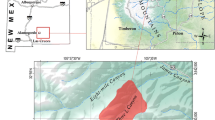Abstract
Results from the study of experimental plots at Hubbard Brook, New Hampshire for the years 1987, 1988, 1993, 1994, 1995, and 1996 show that the water draining from under a plot planted with pine trees exhibits its highest alkalinity during the year at about the time of spring snowmelt. This high alkalinity is believed to be due to buildup during the winter under a snow cover. The soil solutions are protected from acidic precipitation by the snow, and the natural process of the reaction of organic acids and carbonic acid with minerals and exchange complexes to form dissolved HCO3 − (and organic anions) proceeds with an increase in alkalinity through the winter. When the snow melts the acidic meltwater mixes with, neutralizes and displaces the water previously occupying the soil interstices. This leads to a decided drop in alkalinity of the drainage water. The alkalinity buildup under the pine plot was found to be two to ten times greater than under a similar plot containing no higher plants. This strongly emphasizes the important role of plants, in their ability to produce organic acids and high levels of CO2, in accelerating the weathering of silicate minerals.
Similar content being viewed by others
References
Arthur M. A. and Fahey T. J. (1993) Controls on soil solution chemistry in a subalpine forest in North-Central Colorado. Soil Sci. Soc. Am. J. 57, 1123–1130.
Berner E. K. and Berner R. A. (1996) Global Environment: Water, Air and Geochemical Cycles, Prentice-Hall, Upper Saddle River, NJ.
Berner R. A. (1992) Weathering, plants, and the long-term carbon cycle. Geochim. Cosmochim. Acta 56, 3225–3231.
Berner R. A. (1995) Chemical weathering and its effect on atmospheric CO2 and climate. In Chemical Weathering Rates of Silicate Minerals (eds. A. F. White and S. L. Brantley), Rev. Mineral. 31, 565–583.
Bormann F. H., Bowden W. B., Pierce R. S., Hamburg S. P., Voigt G. K., Ingersoll R. C. and Likens G. E. (1987) The Hubbard Brook sandbox experiment. In Restoration Ecology, (ed. R. Jordan et al.) pp. 251–256. Cambridge University Press, Cambridge.
Bormann B. T., Wang D., Bormann F. H., Benoit G., April R. and Snyder R. (1997) Rapid plant induced weathering and soil development in an experimental pine sy
Clow D. C., Swoboda-Colberg N. and Drever, J. I. (1988) Chemistry of snowmelt, soil water, and stream water at the West Glacier Lake Watershed, Wyoming. EOS 69, 202 (abstr.).
Denning A. S., Baron J., Mast M. A. and Arthur, M. A. (1991) Hydrologic pathways and chemical composition of runoff during snowmelt in Loch Vale watershed, Rocky Mountain National Park, Colorado, USA. Water, Air and Soil Pollution 59, 107–123.
Drever J. I. (1988) The Geochemistry of Natural Waters. Prentice-Hall, Englewood Cliffs, NJ.
Drever J. I. and Zobrist J. (1992) Chemical weathering of silicate rocks as a function of elevation in the southern Swiss Alps. Geochim. Cosmochim. Acta 56, 3209–3216.
Fiedler H. J and Katzschner W. (1989) Relationship between basic cations and anions of strong acids in forested bodies of water of low mountain ranges. Hercynia 26, 94–101.
Holland H. D. (1978) The Chemistry of the Atmosphere and Oceans. Wiley, New York.
Hooper R. P., West C. T. and Peters N. E. (1990) Assessing the response of Emerald Lake, an alpine watershed, in Sequoia National Park, California to acidification during snowmelt by using a simple hydrochemical model. U.S. Geol. Survey Water Resources Investigations, p. 68.
Likens G. E. and Bormann F. H. (1995) Biogeochemistry of a Forested Ecosystem 2nd ed. Springer-Verlag, New York.
Moulton K. L. and Berner R. A. (1996) The effect of higher land plants on the weathering of calcium and magnesium silicates in Iceland. 1996 Geol. Soc. Am. Ann. Meet. 339 (abstr.).
Solomon D. K. and Cerling T. E. (1987) The annual carbon dioxide cycle in a montane soil: observations, modeling, and implications for weathering. Water Resources Research 23, 2257–2265.
Stoddard J. L. (1987) Alkalinity dynamics in an unacidified alpine lake, Sierra Nevada, California. Limnol. Oceanog. 32, 825–839.
Stumm W. and Morgan J.J. (1996) Aquatic Chemistry, 3rd Ed. Wiley, New York.
Author information
Authors and Affiliations
Rights and permissions
About this article
Cite this article
Berner, R.A., Rao, JL. Alkalinity buildup during silicate weathering under a snow cover. Aquat Geochem 2, 301–312 (1996). https://doi.org/10.1007/BF00115974
Received:
Revised:
Issue Date:
DOI: https://doi.org/10.1007/BF00115974




